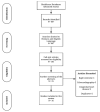Left Ventricular Blood Flow Kinetic Energy Assessment by 4D Flow Cardiovascular Magnetic Resonance: A Systematic Review of the Clinical Relevance
- PMID: 32927744
- PMCID: PMC7569817
- DOI: 10.3390/jcdd7030037
Left Ventricular Blood Flow Kinetic Energy Assessment by 4D Flow Cardiovascular Magnetic Resonance: A Systematic Review of the Clinical Relevance
Abstract
Background: There is an emerging body of evidence that supports the potential clinical value of left ventricular (LV) intracavity blood flow kinetic energy (KE) assessment using four-dimensional flow cardiovascular magnetic resonance imaging (4D flow CMR). The aim of this systematic review is to summarize studies evaluating LV intracavity blood flow KE quantification methods and its potential clinical significance. Methods: A systematic review search was carried out on Medline, Pubmed, EMBASE and CINAHL. Results: Of the 677 articles screened, 16 studies met eligibility. These included six (37%) studies on LV diastolic function, another six (37%) studies on heart failure or cardiomyopathies, three (19%) studies on ischemic heart disease or myocardial infarction and finally, one (6%) study on valvular heart disease, namely, mitral regurgitation. One of the main strengths identified by these studies is high reproducibility of LV blood flow KE hemodynamic assessment (mean coefficient of variability = 6 ± 2%) for the evaluation of LV diastolic function. Conclusions: The evidence gathered in this systematic review suggests that LV blood flow KE has great promise for LV hemodynamic assessment. Studies showed increased diagnostic confidence at no cost of additional time. Results were highly reproducible with low intraobserver variability.
Keywords: 4D flow CMR; 4D flow MRI; cardiovascular magnetic resonance; four-dimensional; intracardiac; phase contrast; systematic review; time-resolved; velocity encoded.
Conflict of interest statement
The authors declare no conflict of interest.
Figures



Similar articles
-
Evaluation of left ventricular blood flow kinetic energy in patients with acute myocardial infarction by 4D Flow MRI: a preliminary study.BMC Med Imaging. 2024 Jun 5;24(1):131. doi: 10.1186/s12880-024-01310-8. BMC Med Imaging. 2024. PMID: 38840059 Free PMC article.
-
Left ventricular blood flow kinetic energy is associated with the six-minute walk test and left ventricular remodelling post valvular intervention in aortic stenosis.Quant Imaging Med Surg. 2021 Apr;11(4):1470-1482. doi: 10.21037/qims-20-586. Quant Imaging Med Surg. 2021. PMID: 33816183 Free PMC article.
-
Kinetic Energy Measured by 4D Flow Cardiac MRI in Evaluating Intraventricular Hemodynamics: A Systematic Review.J Magn Reson Imaging. 2025 Mar 12. doi: 10.1002/jmri.29759. Online ahead of print. J Magn Reson Imaging. 2025. PMID: 40072254 Review.
-
Scan-rescan reproducibility of diastolic left ventricular kinetic energy, viscous energy loss and vorticity assessment using 4D flow MRI: analysis in healthy subjects.Int J Cardiovasc Imaging. 2018 Jun;34(6):905-920. doi: 10.1007/s10554-017-1291-z. Epub 2018 Jan 5. Int J Cardiovasc Imaging. 2018. PMID: 29305740
-
A Systematic Review of Right Ventricular Diastolic Assessment by 4D Flow CMR.Biomed Res Int. 2019 Mar 14;2019:6074984. doi: 10.1155/2019/6074984. eCollection 2019. Biomed Res Int. 2019. PMID: 31001557 Free PMC article.
Cited by
-
Rationale and clinical applications of 4D flow cardiovascular magnetic resonance in assessment of valvular heart disease: a comprehensive review.J Cardiovasc Magn Reson. 2022 Aug 22;24(1):49. doi: 10.1186/s12968-022-00882-0. J Cardiovasc Magn Reson. 2022. PMID: 35989320 Free PMC article. Review.
-
Novel Techniques in Imaging Congenital Heart Disease: JACC Scientific Statement.J Am Coll Cardiol. 2024 Jan 2;83(1):63-81. doi: 10.1016/j.jacc.2023.10.025. J Am Coll Cardiol. 2024. PMID: 38171712 Free PMC article. Review.
-
4D Flow cardiovascular magnetic resonance consensus statement: 2023 update.J Cardiovasc Magn Reson. 2023 Jul 20;25(1):40. doi: 10.1186/s12968-023-00942-z. J Cardiovasc Magn Reson. 2023. PMID: 37474977 Free PMC article. Review.
-
Intraventricular haemodynamic changes caused by increased left ventricular afterload in re-coarctation of aorta: a case report.Eur Heart J Case Rep. 2023 Oct 16;7(11):ytad514. doi: 10.1093/ehjcr/ytad514. eCollection 2023 Nov. Eur Heart J Case Rep. 2023. PMID: 37942351 Free PMC article.
-
Evaluation of Left Ventricular Function Using Four-Dimensional Flow Cardiovascular Magnetic Resonance: A Systematic Review.J Cardiovasc Dev Dis. 2022 Sep 12;9(9):304. doi: 10.3390/jcdd9090304. J Cardiovasc Dev Dis. 2022. PMID: 36135449 Free PMC article. Review.
References
-
- Dyverfeldt P., Bissell M., Barker A.J., Bolger A.F., Carlhäll C.J., Ebbers T., Francios C.J., Frydrychowicz A., Geiger J., Giese D., et al. 4D flow cardiovascular magnetic resonance consensus statement. J. Cardiovasc. Magn. Reason. J. Soc. Cardiovasc. Magn. Reson. 2015;10:17–72. doi: 10.1186/s12968-015-0174-5. - DOI - PMC - PubMed
Publication types
Grants and funding
LinkOut - more resources
Full Text Sources
Miscellaneous

